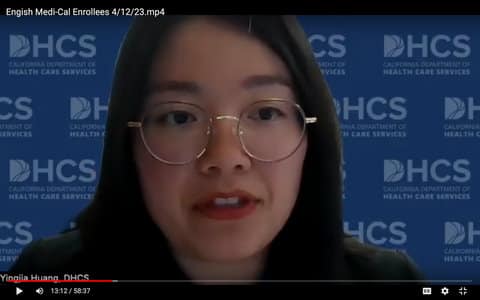
15 May ‘Literally the Only Option’: Medi-Cal Expansion Boosts Access to Healthcare

Yingjia Huang is trying to make Medi-Cal more accessible through her role as assistant deputy director of Health Care Benefits and Eligibility at the California Department of Health Care Services. (Screenshot captured by Joe Porrello / The CC Pulse)
By Joe Porrello
When Dara Montejo’s mother had a seizure last August, the family wouldn’t let EMTs take her to the hospital in an ambulance. They didn’t know how much it would cost — and ambulance rides can be very expensive — so they drove to the emergency room in Dara’s father’s car.
Many people feel forced to make decisions like that because they don’t have health insurance.
“She’s never had (a seizure). I’ve never seen one in my life, so I really thought my mom was dying,” Montejo said. “I wasn’t feeling very safe taking my mom in the car, but that was like literally the only option I felt in that moment that I had, and it was just very scary.”
Now, Montejo said her mother no longer worries about medical bills because she was finally able to get coverage.
On Jan. 1, California made Medi-Cal available to undocumented adults aged 26-49, provided their incomes are below a certain level. (Those 25 and under or 50 and older could already get it.)
That has allowed Montejo’s mother to afford the three prescriptions she takes that would be over $100 apiece without insurance and given her access to CT scans, ambulance rides and necessary treatments.
“It feels really nice to not have to worry about that, especially when I’m not certified to have taken care of my mom if she’s having a seizure,” said Montejo.
But even as more people are becoming eligible, others are at risk of losing their coverage for simply not keeping up with their paperwork. However, Yingja Huang, assistant deputy director of Health Care Benefits and Eligibility at the California Department of Health Care Services, said that Medi-Cal disenrollment rates continue to decrease since December after almost 1 million Californians lost coverage in 2023.
Last year marked the first since 2020 in which the DHCS again began annual reviews on the eligibility of its members following a three-year hiatus due to federal COVID-19 accommodations.
Ethnic Media Services and California Black Media held a press teleconference April 16 to highlight the impact of the “great unwinding” and revamped coverage renewal. Medi-Cal members also discussed the fear of medical bills, a lack of logistic support, and how their coverage has provided comfort.
Approximately one-third of California’s nearly 39 million people are on Medi-Cal, and Huang says she expects that number to grow because of recent strides in the program like the addition of health enrollment navigators to assist with bureaucratic hurdles, streamlined renewal processes, informational online toolkits available in 19 languages, and the expansion of coverage to income-eligible undocumented immigrants.
According to Huang, 700,000 people with Medi-Cal in 2023 who were limited to emergency services are now far less restricted because of the expansion.
Vilma Champion, director of managed care and enrollment at the Northeast Valley Health Corporation in the Los Angeles area, says prioritizing support for immigrants is crucial.
“Communication effectively with Latino or Spanish-speaking communities involves navigating several challenges, especially when considering access to immigration concerns,” she said.
Champion leads over 40 certified enrollment counselors who help patients enroll in Medi-Cal. She said NEVHC “expects to provide health services to over 6,000 newly eligible Medi-Cal patients who will have access to a private network of specialists and hospitals.”
It also provides bilingual materials and staff, community outreach events, and partnerships with trusted local leaders.
Champion said being knowledgeable about one’s coverage and having a full range of benefits can drastically improve overall health for Medi-Cal members.
“As we expand the accessibility of Medi-Cal, we want to make sure that the community is accessing health care services, that we are reaching out to our patients, encouraging them to schedule preventative service, not to wait until they feel sick to access care,” she said.
A Medi-Cal and NEVHC patient going by only her first name, Griselda, said the enrollment counselors have been a big help.
They “are always reaching out to us and helping us with any problems we could have with Medi-Cal,” she said in Spanish through an interpreter, adding that going through clinic employees is easier and faster than trying to reach a government office directly by phone or online.
She credited her coverage for the ability to get her three children annual physicals, as well as them all having access to dental care and for an operation going smoothly that she needed after an aneurysm.
Griselda has since taken it upon herself to stay up to date on health care news and inform members of her community that are unaware of their ability to receive health insurance.
While some people may not know they can get coverage, others don’t know what they need to do to keep it.
When their case comes up for review, those on Medi-Cal can lose coverage for failing to respond, but according to Huang, there is a 90-day grace period after the due date to give required documents and reinstate coverage. Once coverage is reinstated, bills paid out-of-pocket can be reimbursed from the date of discontinuance.
Additionally, those who have applied for or received benefits from Medi-Cal and have a complaint about how services were handled or had services denied or modified can discuss the complaint with a county welfare representative, file a discrimination complaint, or request a hearing.






No Comments